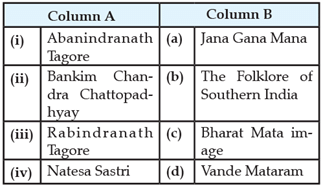Assertion & Reason Test: Nationalism in India - 2 - Class 10 MCQ
11 Questions MCQ Test History for Class 10 - Assertion & Reason Test: Nationalism in India - 2
Direction: Mark the Option Which Is Most Suitable:
Assertion : The council elections were boycotted in most provinces except Madras.
Reason : In many places, merchants and traders refused to trade in foreign goods or finance foreign trade.
Direction: Mark the Option Which Is Most Suitable:
Assertion : In Awadh, the peasants were led by Alluri Sitaram Raju.
Reason : The movement here was against Oudh Kisan Sabha.
Direction: Mark the Option Which Is Most Suitable:
Assertion : Gandhiji entered into the Gandhi-Irwin Pact on 5 March 1931.
Reason : Ghaffar Khan and Jawaharlal Nehru were both put in jail, the Congress was declared illegal, and a series of measures had been imposed to prevent meetings, demonstrations and boycotts.
Assertion(A): In India rise of nationalism is associated with the anti-colonial movement.
Reason(R): The sense of being oppressed under colonialism connected many different groups together.
Analyze the information given below, considering one of the following correct options:
Mahatma Gandhi’s letter was, in a way, an ultimatum. If the demands were not fulfilled by 11 March, the letter stated, the Congress would launch a civil disobedience campaign. Irwin was unwilling to negotiate. So Mahatma Gandhi started his famous salt march accompanied by 78 of his trusted volunteers. The march was over 240 miles, from Gandhi's ashram in Sabarmati to the Gujarati coastal town of Dandi. The volunteers walked for 24 days, about 10 miles a day. Thousands came to hear Mahatma Gandhi wherever he stopped, and he told them what he meant by swaraj and urged them to peacefully defy the British. On 6 April he reached Dandi, and ceremonially violated the law, manufacturing salt by boiling sea water.
Arrange the following in the correct sequence:
Certain events are given below. Choose the appropriate chronological order:
(i) Coming of Simon Commission of India
(ii) Demand of Purna Swaraj in Lahore Session of INC
(iii) Government of India Act, 1919
(iv) Champaran Satyagraha
Arrange the following in the correct sequence:
Certain events are given below. Choose the appropriate chronological order:
(i) Rowlatt Act passed.
(ii) The Partition of Bengal officially came into existence.
(iii) Satyagraha Movement in Ahmedabad.
(iv) Satyagraha Movement in Kheda District (Gujarat)
Match the following items given in Column A with those in Column B:

In the questions given below, there are two statements marked as Assertion (A) and Reason (R). Read the statements and choose the correct option:
Assertion (A) : Dyer entered the area, blocked the exit points, and opened fire on the crowd, killing hundreds.
Reason (R) : His object, as he declared later, was to 'produce a moral effect', to create in the minds of satyagrahis a feeling of terror and awe.
In the questions given below, there are two statements marked as Assertion (A) and Reason (R). Read the statements and choose the correct option:
Assertion (A) : Foreign goods were boycotted, liquor shops picketed, and foreign cloth burnt in huge bonfires.
Reason (R) : Students and teachers began trickling back to government schools and lawyers joined back work in government courts.
|
27 videos|79 docs|36 tests
|


















